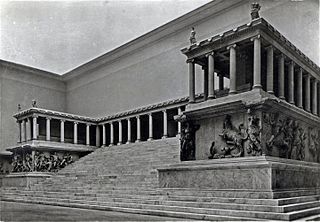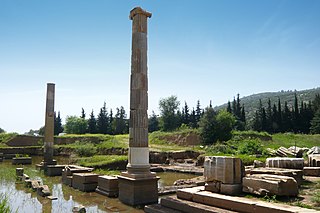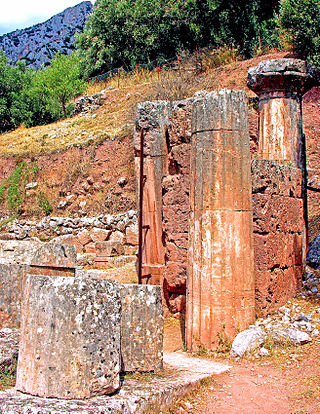Related Research Articles

Delphi, in legend previously called Pytho (Πυθώ), was an ancient sacred precinct and the seat of Pythia, the major oracle who was consulted about important decisions throughout the ancient classical world. The ancient Greeks considered the centre of the world to be in Delphi, marked by the stone monument known as the omphalos (navel).

Pergamon or Pergamum, also referred to by its modern Greek form Pergamos (Πέργαμος), was a rich and powerful ancient Greek city in Mysia. It is located 26 kilometres (16 mi) from the modern coastline of the Aegean Sea on a promontory on the north side of the river Caicus and northwest of the modern city of Bergama, Turkey.

Didyma was an ancient Greek sanctuary on the coast of Ionia in the domain of the famous city of Miletus. Apollo was the main deity of the sanctuary of Didyma, also called Didymaion. But it was home to both of the temples dedicated to the twins Apollo and Artemis. Other deities were also honoured within the sanctuary. The Didymaion was well renowned in antiquity because of its famed oracle. This oracle of Apollo was situated within what was, and is, one of the world's greatest temples to Apollo. The remains of this Hellenistic temple belong to the best preserved temples of classical antiquity. Besides this temple other buildings existed within the sanctuary which have been rediscovered recently; a Greek theatre and the foundations of the above-mentioned Hellenistic temple of Artemis, to name but two.

The Pergamon Altar was a monumental construction built during the reign of the Ancient Greek King Eumenes II in the first half of the 2nd century BC on one of the terraces of the acropolis of Pergamon in Asia Minor.

The sanctuary of Minerva at Portonaccio is an archaeological site on the western side of the plateau on which the ancient Etruscan city of Veii, north of Rome, Italy, was located. The site takes its name from the locality within the village of Isola Farnese, part of Municipio XX, city of Rome.

Classical sculpture refers generally to sculpture from Ancient Greece and Ancient Rome, as well as the Hellenized and Romanized civilizations under their rule or influence, from about 500 BC to around 200 AD. It may also refer more precisely a period within Ancient Greek sculpture from around 500 BC to the onset of the Hellenistic style around 323 BC, in this case usually given a capital "C". The term "classical" is also widely used for a stylistic tendency in later sculpture, not restricted to works in a Neoclassical or classical style.

Hierapolis was originally a Phrygian cult centre of the Anatolian mother goddess of Cybele and later a Greek city. Its location was centred upon the remarkable and copious hot springs in classical Phrygia in southwestern Anatolia. Its extensive remains are adjacent to modern Pamukkale in Turkey.

Claros was an ancient Greek sanctuary on the coast of Ionia. It contained a temple and oracle of Apollo, honored here as Apollo Clarius. It was located in the territory of Colophon, which lay twelve kilometers to the north, one of the twelve cities of the Ionian League. The coastal city Notion lay two kilometers to the south. The ruins of the sanctuary are now found north of the modern town Ahmetbeyli in the Menderes district of Izmir Province, Turkey.

The Ludovisi Gaul is an ancient Roman statue depicting a Gallic man plunging a sword into his breast as he holds up the dying body of his wife. This sculpture is a marble copy of a now lost Greek bronze original. The Ludovisi Gaul can be found today in the Palazzo Altemps in Rome. This statue is unique for its time because it was common to depict the victor but instead, the Ludovisi Gaul depicts the defeated.

Delphi Archaeological museum is one of the principal museums of Greece and one of the most visited. It is operated by the Greek Ministry of Culture. Founded in 1903, it has been rearranged several times and houses the discoveries made at the Panhellenic sanctuary of Delphi, which date from the Late Helladic (Mycenean) period to the early Byzantine era.

The Athenian Treasury at Delphi was constructed by the Athenians to house dedications and votive offerings made by their city and citizens to the sanctuary of Apollo. The entire treasury including its sculptural decoration is built of Parian marble. The date of construction is disputed, and scholarly opinions range from 510 to 480 BCE. It is located directly below the Temple of Apollo along the Sacred Way for all visitors to view the Athenian treasury on the way up to the sanctuary.

The Sphinx of Naxos, also Sphinx of the Naxians, now in the Archaeological Museum of Delphi, is a 2.22 meter tall marble statue of a sphinx, a mythical creature with the head of a woman, the chest and wings composed of the impressive feathers of a prey bird turned upward, and the body of a lioness. The Sphinx stood on a 10 meters column that culminated in one of the first Ionic capitals, and was erected next to the Temple of Apollo in Delphi, the religious center of Ancient Greece, in 560 BCE.
Among the famous ex votos of Delphi was that of Craterus, friend and general of Alexander the Great, attributed to Lysippos.

The Temple of Athena Pronaia was a temple at the ancient site of Delphi, in the Sanctuary of Athena Pronaia, a group of buildings comprising temples and treasuries as well as the famous Tholos of Delphi. There were in fact three successive temples built at the site. The earlier temples (38°28′49″N22°30′30″E), referred to as A and B, were built in the 7th and 6th centuries BC respectively and were made of porous stone; a third temple (38°28′49″N22°30′28″E) was built of limestone in the 4th century BC, although it is not certain that it actually was dedicated to Athena this time.

The tenth book of the work Description of Greece by the traveler Pausanias is dedicated to Phocis; its larger part constitutes a description of the sanctuaries and buildings of Delphi. His work constituted a precious aid to travelers and archaeologists who attempted to identify the monuments revealed by the excavations, although in some cases their identifications were not enough.

The stele of Prusias is one of the ex votos at the sanctuary of Apollo in Delphi, constructed in honour of king Prusias II of Bithynia.
The Halos was a round open space close to the temple of Apollo in Delphi, where ancient rituals were being performed.
One of the important ex votos of the Greek cities in the sanctuary of Delphi was the bronze sculpted ex voto of the Italian city of Tarentum in commemoration of their victory against the Messapians.
The city of Argos dedicated several ex votos within the sanctuary of Apollo in Delphi. It was, after all, one of the most powerful cities of the archaic and classical period.

Behind the column with the Dancers of Delphi was situated the Athenian Treasury, where was located the famous ex voto of Daochos, a long marble base where stood nine statues, eight of which represented members of Daochos' family and one a god, probably Apollo. Daochos II, son of Agias, a politician from Pharsalus and supporter of Macedonia, was a hieromnemon at the delphic sanctuary from 336 to 332 B.C. He dedicated the ex voto as a sign of honour to his prominent family.